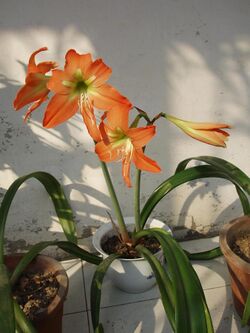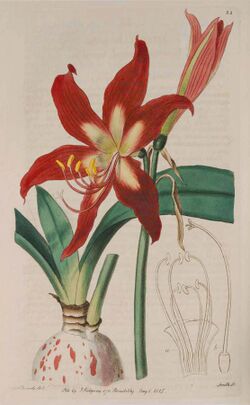Biology:Hippeastrum striatum
| Hippeastrum striatum | |
|---|---|

| |
| Scientific classification Error creating thumbnail: Unable to save thumbnail to destination
| |
| Kingdom: | Plantae |
| Clade: | Tracheophytes |
| Clade: | Angiosperms |
| Clade: | Monocots |
| Order: | Asparagales |
| Family: | Amaryllidaceae |
| Subfamily: | Amaryllidoideae |
| Genus: | Hippeastrum |
| Species: | H. striatum
|
| Binomial name | |
| Hippeastrum striatum | |
| Synonyms | |
|
Numerous, including various species of | |
Hippeastrum striatum, the striped Barbados lily, a flowering perennial herbaceous bulbous plant, in the family Amaryllidaceae, native to the southern and eastern regions of Brazil .[2]
Description
The flowers, generally 2–4, are smaller than other members of the genus. The paraperigon features bristles at the throat of the tepal tube. The perigone is about 7.6–10 cm in size and the tepal segments are 2–2.5 cm broad in their middle. Their colour is a bright red with a green keel that extends halfway up the segment. The stigma is trifid. [5]
Taxonomy
Described in 1963 in Baileya.[6] the name is derived from the Latin word striatus (striped).[7] It is similar to H. petiolatum and H. puniceum.[5]
Earlier synonyms have included species of Callicore and Lais, now considered to be Hippeastrum, as well as species of Amaryllis, from which Hippeastrum was separated.
Distribution
Brazil.
Ecology
Produces numerous bulbils that facilitate its escape and naturalisation in tropical areas. It will grow from seeds in about two years.[5]
References
- ↑ Baileya 11: 16 (1963).
- ↑ 2.0 2.1 WCLSPF 2016, Hippeastrum striatum.
- ↑ The Plant List 2013, Hippeastrum striatum.
- ↑ WCLSPF 2016, Synonyms.
- ↑ 5.0 5.1 5.2 PBS 2015, Hippeastrum striatum.
- ↑ Tropicos 2015, Hippeastrum striatum.
- ↑ Griffith 2005, striatus.
Bibliography
- "Pacific Bulb Society Wiki". Pacific Bulb Society. 2014. http://www.pacificbulbsociety.org/pbswiki/index.php/HomePage.
- "Tropicos". Missouri Botanical Garden. 2015. http://www.tropicos.org/Home.aspx.
- Zuloaga, Fernando O.; Morrone, Osvaldo; Belgrano, Manuel J., eds (2008). "Hippeastrum" (Monogr. Syst. Bot. Missouri Bot. Gard. 107). Catálogo de las plantas vasculares del Cono Sur: (Argentina, Sur de Brasil, Chile, Paraguay y Uruguay). St. Louis, Mo.: Missouri Botanical Garden. ISBN 978-1-930723-70-2. http://www2.darwin.edu.ar/Proyectos/FloraArgentina/Generos.asp?genus=Hippeastrum.
- "World Checklist of Selected Plant Families". Royal Botanic Gardens, Kew. http://apps.kew.org/wcsp/.
- Griffith, Chuck (2005). "Dictionary of Botanical Epithets". http://www.winternet.com/~chuckg/dictionary/dictionary.34.html.
- The Plant List (2013). "The Plant List Version 1.1". Royal Botanic Gardens, Kew and Missouri Botanical Garden. http://www.theplantlist.org/.
- Forzza, R. C. et al. 2010. 2010 Lista de espécies Flora do Brasil.
| Wikimedia Commons has media related to Hippeastrum striatum. |
Wikidata ☰ Q9003927 entry
 |


